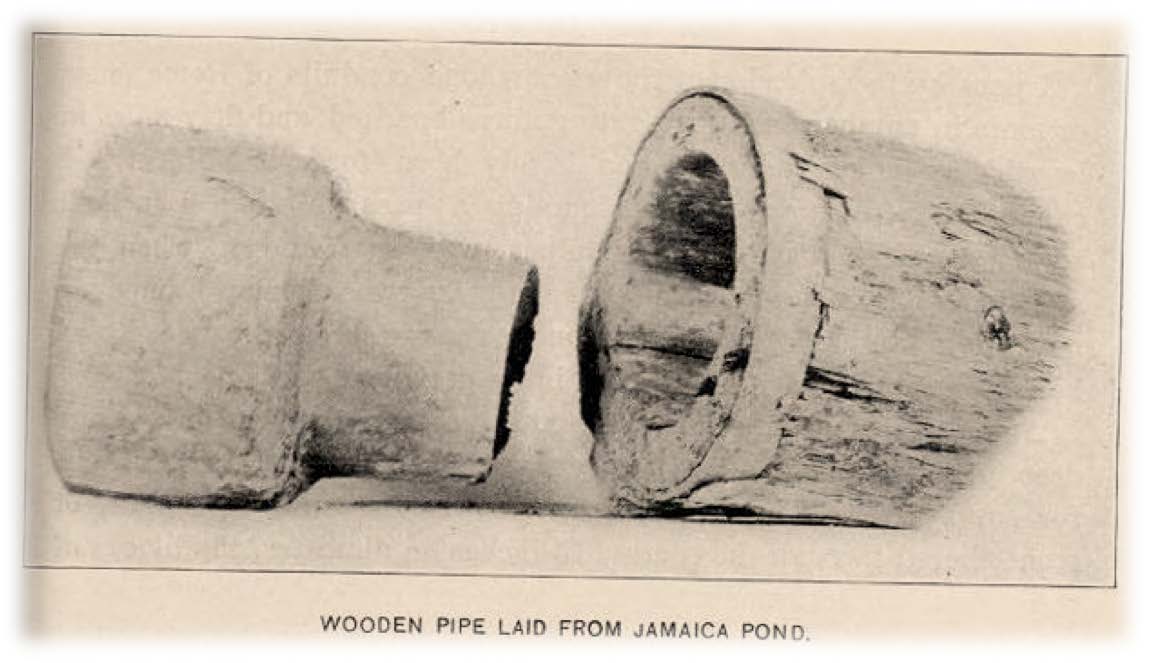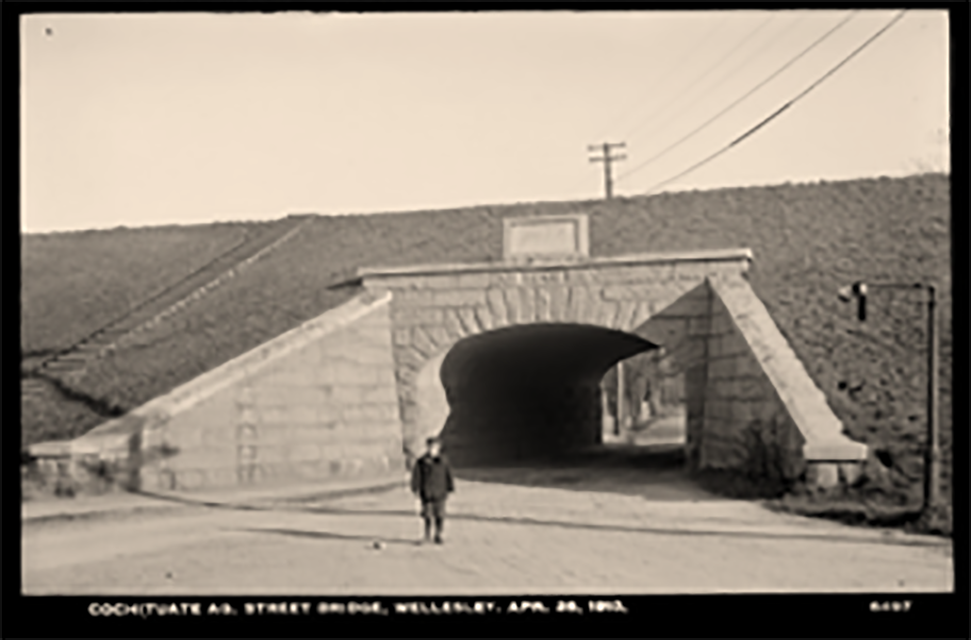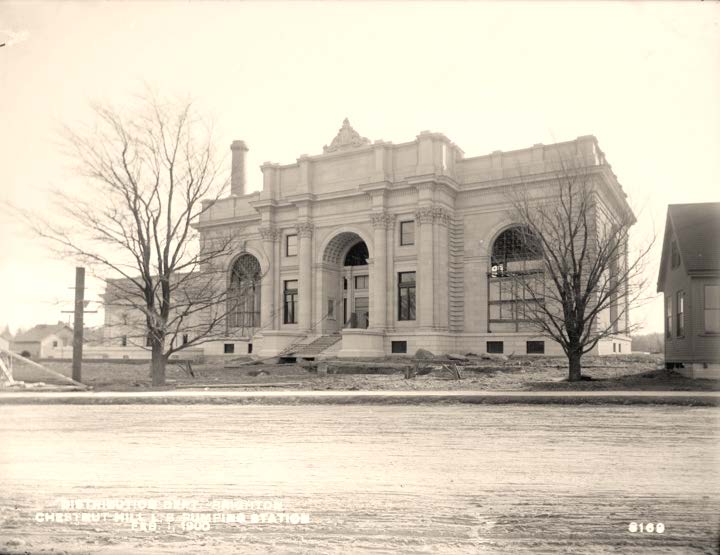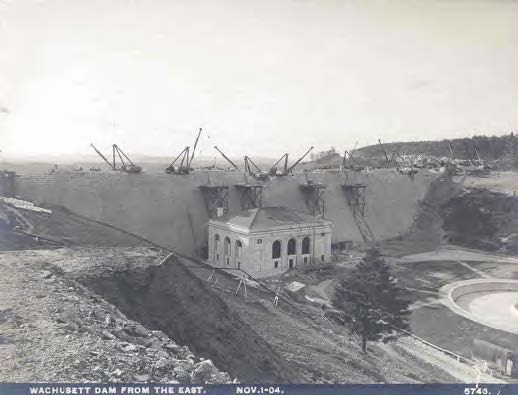Early Water Sources for Boston
When the Boston area cities and towns first faced the problems of providing clean water sources in the 1600s, their methods were primitive, relying on local wells, rain barrels, and a spring on the Boston Common. By 1795 wooden pipes delivered water from a centralized water supply at Jamaica Pond to Boston proper.
Wooden Pipe Laid from Jamaica Pond
By the late 1840s, however, Jamaica Pond was too small and too polluted to provide water to Boston’s 50,000 residents. So, the pattern of continually moving westward in search of larger fresh water sources began.
Cochituate System: 1848-1951
In 1845, the Cochituate Water Board began construction of a new water supply and transmission system. A tributary of the Sudbury River was impounded, which created Lake Cochituate. Lake Cochituate, with its 17 square miles of watershed, 2 billion gallons of storage and yield of 10 mgd, became the cornerstone of the Boston water system.
Cochituate Aqueduct, Cedar Street Bridge, April, 1910
The Cochituate Aqueduct, extending 14.5 miles, was completed to transport water to the Brookline Reservoir and then to smaller distribution reservoirs in all parts of the city. This aqueduct was in service for approximately 100 years, until 1951, when water quality had declined and alternate methods of transporting water to the hub of the distribution system had been constructed.
The Sudbury Aqueduct and Chestnut Hill Reservoir: 1878
Boston grew rapidly after the Irish Potato Famine of 1843-45 and by 1870, its population exceeded 200,000 and consumed 17 mgd of water. Planners had not anticipated this rapid growth; they thought that the Cochituate system would be adequate for many years. In order to provide the growing city with the water it needed, the process of diverting water from a western pure upland source was repeated. In 1878, the mainstream of the Sudbury River was diverted via the Sudbury Aqueduct to the Chestnut Hill Reservoir.
Low Service Pump Station at the Chestnut Hill Reservoir, 1900
Between 1875 and 1898, seven major reservoirs were constructed in the Upper Sudbury River Watershed. The Sudbury and Cochituate Aqueducts were designed to operate by gravity to fill the Chestnut Hill and Brookline Reservoirs.
Wachusett Reservoir: 1897
The Boston metropolitan area continued to grow rapidly through the 1890s. Indoor plumbing became commonplace. Planners had not foreseen this development and the current water supply had become inadequate. Under the leadership of Frederick Stearns, Chief Engineer of the Boston Water Board, it was decided that a new water source that could be gravity-operated and not require filtration was required.
In 1897, the Nashua River above the Town of Clinton in Central Massachusetts was impounded by the Wachusett Dam. Six and 1/2 square miles were flooded and water conveyed by the Wachusett/Weston Aqueduct to the Weston Reservoir and then by pipeline to the Chestnut Hill and Spot Pond Reservoirs.
Wachusett Dam, 1904
Work was completed in 1905 and the reservoir first filled in May 1908. The Wachusett system was built to service the 29 municipalities within the 10 mile radius of the Massachusetts State House. At the time, the Wachusett Reservoir was the largest public water supply reservoir in the world with a capacity of 65 billion gallons.
Quabbin Reservoir, Ware River Intake and Hultman Aqueduct: 1926 -1946
Eventually the Wachusett System became inadequate for the increasingly industrialized city and a westward focus for a new water source resumed. The Quabbin Reservoir was Boston's fourth westward reach for a pure upland source of water that could be delivered by gravity and not require filtration. Construction of the Quabbin Reservoir required impoundment of the Swift River and the taking of the towns of Dana, Enfield, Greenwich, and Prescott. In 1926, construction began on the Wachusett-Coldbrook Tunnel, which is now the eastern section of the Quabbin Tunnel.
Loaded Muck Cars - Bottom of Shaft #2, 1930
During the 1930s, the Wachusett-Coldbrook Tunnel was extended to the Swift River. It is a two-way tunnel: water flows west from the Ware River to the Quabbin during the high-water months and then east from the Quabbin Reservoir to Wachusett at other times of the year.
Construction on the Quabbin Reservoir began in 1936. Filling commenced in 1939 and was completed in 1946 when water first flowed over the spillway. At the time, the 412-billion-gallon reservoir was the largest man-made reservoir in the world which was devoted solely to water supply. The existing reservoirs, located at sufficiently high elevations, could now supply an abundant supply of water to the metropolitan Boston area by gravity through pressurized aqueducts or tunnels.
In the 1940s, planners believed that the Quabbin Reservoir will be sufficient to supply the metropolitan area into the foreseeable future, and at the time, was the last major investment in the water system with no plans in place for upgrades to carry the system into the next century. Many of the previous expansions used gravity for supplying water instead of costly pumping. Fortunately, these crucial foundations laid by the early water engineers provide the backbone of the system we run today.
Origins of the Pressure Aqueduct System (Hultman Aqueduct):
1937-1941
In 1937, a plan was developed for a high service pressure aqueduct system to deliver water to the Metropolitan area. A portion of the plan included two parallel aqueducts to carry water from the Wachusett Aqueduct to the new Norumbega Reservoir and the terminus of the Weston Aqueduct in the Town of Weston. Work began on schedule in 1939 and by the outbreak of World War II in 1941, one of the two proposed parallel Pressure Aqueducts had been built. This portion of the Pressure Aqueduct is the Hultman Aqueduct.
Metropolitan Pressure Aqueducts and Tunnels
1950-1978 After WWII, additional segments of the pressurized transmission system came online with the construction of the Chicopee Valley Aqueduct, Metropolitan Tunnel System and the Cosgrove Tunnel. As these sections of the pressure transmission system have come online, the need for pumping from open reservoirs was reduced since more of the service area could be supplied by this pressurized transmission system. Older facilities which originally provided a level of redundancy to the new pressure tunnels were eventually retired from use. More reliance was placed on the newer pressurized system to the point where it is now relied upon to deliver 85% of the Metropolitan area demand.




